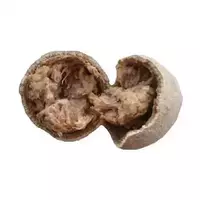Feronia (wooden apple)

Feronia lemon or wooden apple is a fruit tree, which is ranked among the Rutov family. Its homeland is considered to be Sri Lanka and India, where feronia (a wooden apple) is actively grown, planted in gardens and along roads. In addition, these trees are widely cultivated everywhere in Southeast Asia, especially in Malaysia.
In general, the feronia (wood apple) plant is a medium-sized, slow-growing straight tree that is distinguished by strong spines, wrinkled bark and long dark green leaves. When rubbed, the leaves are fragrant with a pleasant lemon aroma.
After the small pale red flowers wilt, fruit ovaries appear on the trees, which gradually turn into spherical fruits of gray color. The fruits of feronia (a wooden apple), the diameter of which varies from 5 to 1
2. 5 centimeters, are distinguished by a rigid tree shell. Inside the fruit there is brown flesh with a large number of small white seeds. The aromatic pulp of feronia (wooden apple) is powdery, sticky and astringent in consistency, sweet to taste.
Ripe fruits of feronia (wooden apple) are rich in beta-carotene, which is the precursor to vitamin A. In addition, they contain a lot of riboflavin and thiamine, as well as vitamin C. In the pulp of feronia (wooden apple) there is bergapten, stigmasterin, orientine, psoralene, saponins, essential oil and tannins. Alkaloids, fatty acids, coumarins and sterols have been found in the pericarp.
The flesh of the fruits of feronia (a wooden apple) is edible, unlike the shell, which must first be broken. The inside of ripe fruits is usually mixed with sugar, palm syrup or coconut milk, and then eaten as sherbet. In addition, drinks are prepared from these fruits, jam, ice cream and sweets are made. The fruits of feronia (a wooden apple) are also used to make jelly, canned fruit and chutney.
In Sri Lanka, for example, the flesh of feronia (a wooden apple) is used to make cream, while the people of Indonesia eat it for breakfast. In the homeland of this plant - in India - the fruits are used in a similar way to the bail (stone apple). In Thailand, it is customary to consume young leaves of feronia (a wooden apple) as a fresh green salad.
Ripe fruits of feronia (a wooden apple) are characterized by astringent and tonic properties - they are often used as a gastric remedy. Pulp juice is used for sore throat and stomatitis, diarrhea and dysentery. The leaves are also inherent in astringent properties, thanks to which the decoction helps with vomiting, indigestion, hiccups and dysentery. Eating seeds of pheronia (a wooden apple) contributes to the treatment of heart disease.
It is worth noting that the pulp of feronia (a wooden apple) is characterized by a soap-like effect, in connection with which it can be used as a detergent. The sticky layer around immature seeds finds use in jewelry, where it is used as a household glue.
Feronia (wooden apple) wood is also highly valued - it is used in the process of building houses, making agricultural tools and pillars. The peel of the fruit is so strong that it can be used as utensils. In addition, the peel of the fruits of feronia (a wooden apple) contains essential oil, often used as a hair flavor.
ferony (wooden apple) 50 kCal
The energy value of pheronia (wooden apple) (Ratio of proteins, fats, carbohydrates - ju):
Proteins: 0.3 g (~ 1 kCal)
Fats: 0.2 g (~ 2 kCal)
Carbohydrates: 12g (~ 48kCal)
Energy ratio (bj | y): 2% | 4% | 96%
 Español
Español Français
Français Português
Português Русский
Русский 简体中文
简体中文 繁體中文
繁體中文 日本語
日本語 한국어
한국어 العربية
العربية Türkçe
Türkçe Қазақ
Қазақ Deutsch
Deutsch Italiano
Italiano Українська
Українська
